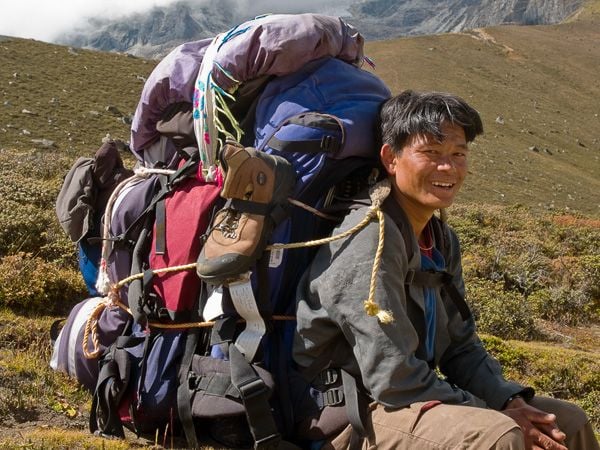Porters Packing Bags
After spending a week in the mountain village of Walongchung Gola in northeastern Nepal, the day we left could only be described as beautiful. It was probably the first truly beautiful day weatherwise since landing in Kathmandu. The sky was not only clear but a piercing blue, a stark contrast to the constant smoggy gray of the city… which I recently learned is the 7th most polluted city in the world. We were spoiled with fresh mountain air that we could actually breath since we were finally adjusted to the altitude.
We made the decision to hire porters to carry our bags down, an option we were completely unaware of on the way up. At first, I felt like we were almost cheating by not carrying them ourselves, but I was reminded that pride could not be an issue and we need to use wisdom because our bodies were physically not capable of completing the task without help.
These are without a doubt the strongest men I have ever met… all of them. Despite being incredibly thin, both porters strapped three packs to their back and head (a total of close to 100lbs) and then began to run with them. We were only able to keep up with them a small portion of the time and we had around 3lbs worth of baggage in our day packs. When we finally reached lunch, each of them refueled on a huge plate of daal bhat (a traditional rice-lentil-curry dish) and greens.
Shelby and I watched the porters the first day and studied how they moved, resolving ourselves to give it a go because of the obvious results of their technique. We watched their feet as they jogged down the steep slopes, light as a feather on their feet. Next, it was our turn. At first, planning where I would place my feet several steps in advance as I hurtled down the mountain required my brain to be quite active, but after awhile my brain kind of turned off and feet began to instinctively just ‘find’ where to go, flying down the dry rocks, which would soon become wet with the onset of monsoon coming just days later.
In Nepal, like all people, the porters support the weight they carry with a strap around their head. The culture here finds it very strange that Americans carry heavy items with both arms in front or in a backpack. I’ve even seen school children using a single strap on a standard backpack around their forehead to carry a large load of books.
It is standard for a male Nepali porter to be able to carry around 90% of his body weight up and down the mountains. The strong men are well compensated by the tourism industry on main trekking routes, and are usually paid double the amount of days they are carrying the packs, so that they receive compensation for their return trek home.

Photo from: https://ecoclub.com/headlines/interviews/all-interviews/912-131218-jim-duff
